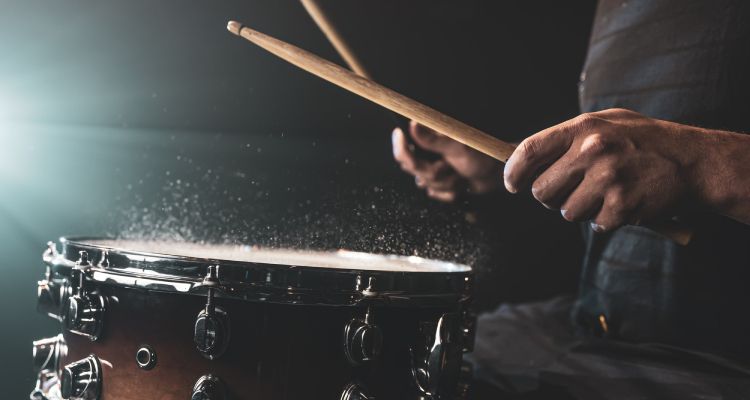Playing the drums is a lot more physically demanding than most other instruments. You need to apply force using all four of your limbs to get notes out, and many people don’t realize how that can affect your body over time.
So, injuries are a lot more common for drummers than they are for other musicians. As drummers, we need to be aware of what injuries may happen so that we can prevent them.
In this guide, we’ll look through several types of drummer injuries that may arise, and I’ll give you some tips to avoid them.
Contents
Why It’s Important to Prevent Drumming Injuries
It’s important to protect your body so that you can play drums for as long as possible.
The best thing about playing an instrument is that you can play most of them until you’re old, and that gives them an edge over things like sporting activities.
However, you won’t be able to play for as long if you develop serious injuries that stop you from being able to play. Some are a lot more serious than others, but they’re all hindrances to your ability to play.
Even if you can play with a certain injury, you won’t be able to play as well as you would if you didn’t have it.
So, healthy drummers are the best drummers.
Common Injuries with Strategies to Avoid Them
Blisters

Blisters are one of the mildest injuries you can get while drumming. Everyone gets them, and they’re a sign of repetitive contact from your sticks with your hands.
They’re the most normal injury you can get from playing the drums, and they shouldn’t be any cause for concern. Beginners tend to get them more as their hands haven’t developed calluses from the sticks yet.
However, even experienced drummers often get them on their hands when they practice for long hours or play the drums extensively on lengthy tours.
While you can take a few measures to prevent blisters, it’s best to let them come some that your hands start to protect themselves from them naturally. The more you play over time, the fewer blisters you’ll get.
If you really want to avoid them, you could play the drums with a pair of gloves.
Wrist Pain
Drumming wrist pain is caused by poor stick holding technique. It’s something that many beginner drummers struggle with if their drumming technique is never corrected. However, experienced drummers often struggle with it after decades of playing as well.
When you feel pain in your wrists, it could be a result of tendonitis, carpel tunnel syndrome, or a repetitive stress injury. These occur when you constantly hit the drums in a way that isn’t natural for your wrists.
Correcting your drumming technique is the best way to help with wrist pain.
The most natural movement for your wrist is to go up and down with your palms facing the floor. If you move the sticks like this to play the drums, you’ll have less chance of damaging your wrists.
Also, make sure to keep a loose grip. It needs to be firm enough to keep the sticks in place but relaxed enough to allow the sticks to rebound off the drums.
If your grip is too tight, you’ll put even more stress on your wrists when striking the drums.
Forearm Fatigue and Elbow Pain

Forearm fatigue comes when you rely too much on your arms to get power behind your strokes. Drumming is all about balancing your fingers, wrists, and arms to ergonomically play as comfortably and skillfully as possible.
Many drummers play the drums by holding their arms too far out from their bodies. If you keep your elbows at your sides, you won’t be able to put as much stress on your arms when playing hard.
Elbow pain is something that comes along with this if you play with your arms out for long periods. Not only will the force hit your forearms, but it will also hit your elbows.
You may put stress on your arms and elbows even if you play with good technique. This usually comes when you try to play while your joints haven’t warmed up.
To prevent this, you should do a quick warmup every time you play the drums. Warming up is especially important before playing live gigs, as the energy of playing a live gig tends to hit drummers’ bodies harder than when they play in a practice room.
The warmup will help your wrists as well. You should do a pattern warmup by playing patterns on the snare or a practice pad, but you should also do a stretching warmup where you pull on your arms to relax them.
Shoulder Pain
Shoulder pain is one of the more serious drummer injuries that creeps up on drummers over time. It gets worse as drummers don’t realize how much damage they’re doing to their shoulders until it’s too late.
Rotator cuff injuries are one of the biggest drumming injuries out there.
You can damage your rotator cuffs by constantly lifting your arms above your head and then putting force on them. The most common place for this to happen is when drummers position their cymbals too high.
It’s best to place your cymbals at eye level or just below to prevent a rotator cuff injury from happening.
You can also get shoulder injuries by placing your drums in awkward places. Some drummers get shoulder injuries on the arm that plays the snare drum the most. This is because their snare drum is placed at an awkward height that isn’t natural for the body.
If you’re feeling pain in your shoulders, check to see that all your drums are positioned ergonomically.
Back Pain

Back pain is another serious injury that drumming can cause. It’s one of the worst injuries as it can become debilitating to other areas apart from drumming.
The biggest cause of drummer lower back pain is having bad posture while playing the drums.
Since most drum thrones don’t have backrests, many drummers start to slouch and tilt their necks. The more you sit like this over time, the easier it can trigger back pain.
When sitting at the drums, you need to sit with your back straight and your neck positioned confidently. It can become so easy to forget about your posture, but you need to keep track of it to prevent future pain.
I’ve written a comprehensive guide to playing drums with the correct posture for you to check out.
Once you get used to sitting straight at the drums, it will become a natural thing to do.
While having a backrest seems like it will help this, they often make drummers lazy with their posture, so you should learn to sit straight on a normal throne first.
Drummer Injury FAQs
Is Drumming Hard on the Body?
Drumming is a lot harder on the body than many other instruments. You need to move all four of your limbs with force to play notes, and that can put a lot of stress on your body if you don’t do it with the correct techniques.
Do Drummers Have Wrist Problems?
Not all drummers have wrist problems, but they’re very common amongst drummers who don’t play with good technique or who don’t do regular warmups before playing.
It’s vital to play the drums in a way that is easy on the wrists. If you play in a way that goes against the natural movement of your wrists, problems will start to arise.
Do Drummers Get Arthritis?
There have been no substantial links between drumming and arthritis over the years. While drumming does put stress on your joints, low-impact playing is actually beneficial for your body to prevent arthritis.
So, if you’re a casual drummer who plays gigs, does regular warmups, and doesn’t bash your drums intently every time you play, you won’t need to worry about drumming causing arthritis.
If you’re a rock drummer who always plays extremely energetically, just make sure to warm up and play as ergonomically as possible.
How Can Drumming Injuries Be Prevented?
The best ways to prevent injuries are to play with proper technique. When you play with good technique, you allow your drumsticks to work with your body instead of against it, and that stops injuries from happening.
You also need to regularly warm up. Since drumming is a physical activity, your joints need to be warm while playing. The colder they are, the more chance of injury there is. It’s very similar to playing a sport.
Final Thoughts
The best thing to do to prevent injuries on the drums is to record yourself playing. When watching yourself, you’ll be able to see if you’re sitting straight and holding your sticks correctly.
You can make subtle corrections to your technique after that that will go a long way in preventing future injuries. It’s all about staying as healthy as possible so that you can play the drums for a very long time.
If you’re unsure of what to correct, get a good drum teacher to watch you play and keep you accountable. Many drummers have done this and thanked themselves for it in the future.









